The Pain Therapeutic Solutions Market is estimated to be valued at USD 91.1 billion in 2025 and is projected to reach USD 145.6 billion by 2035, registering a compound annual growth rate (CAGR) of 4.8% over the forecast period.
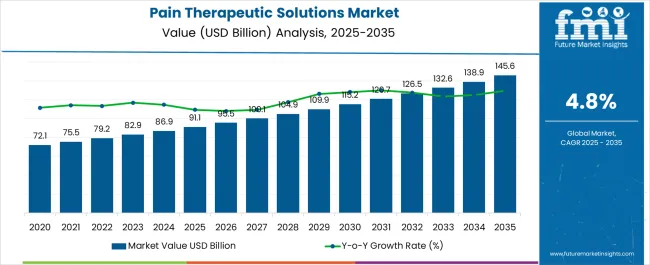
| Metric | Value |
|---|---|
| Pain Therapeutic Solutions Market Estimated Value in (2025 E) | USD 91.1 billion |
| Pain Therapeutic Solutions Market Forecast Value in (2035 F) | USD 145.6 billion |
| Forecast CAGR (2025 to 2035) | 4.8% |
The pain therapeutic solutions market is advancing steadily, driven by the rising prevalence of acute and chronic pain conditions across diverse patient populations. Increasing demand for effective treatment regimens is being influenced by the growing incidence of cancer, musculoskeletal disorders, post-operative pain, and neurological conditions. The market is also benefiting from heightened awareness about pain management and expanding healthcare access in both developed and emerging regions.
Innovation in drug formulations, novel delivery mechanisms, and the introduction of combination therapies are supporting broader adoption across treatment settings. Regulatory bodies are emphasizing the importance of safe and effective pain management practices, which is encouraging investment in non-opioid therapeutic classes to address concerns over dependency.
Additionally, a shift toward personalized medicine and targeted therapies is creating new opportunities for tailored pain relief interventions As patient-centric care models expand and healthcare systems prioritize quality of life outcomes, the pain therapeutic solutions market is expected to continue growing, with pharmaceutical companies focusing on differentiated offerings that balance efficacy, safety, and accessibility.
The pain therapeutic solutions market is segmented by drug class, indication, pain type, distribution channel, and geographic regions. By drug class, pain therapeutic solutions market is divided into NSAIDs, Anticonvulsant, Anaesthetics, Antidepressant Drugs, Anti-Migraine Drugs, Opioids, and Others. In terms of indication, pain therapeutic solutions market is classified into Cancer Pain, Arthritic Pain, Neuropathic Pain, Post-Operative Pain, Bone Fracture, and Others. Based on pain type, pain therapeutic solutions market is segmented into Chronic and Acute. By distribution channel, pain therapeutic solutions market is segmented into Hospital Pharmacies, Retail Pharmacies, and Online Pharmacies. Regionally, the pain therapeutic solutions industry is classified into North America, Latin America, Western Europe, Eastern Europe, Balkan & Baltic Countries, Russia & Belarus, Central Asia, East Asia, South Asia & Pacific, and the Middle East & Africa.
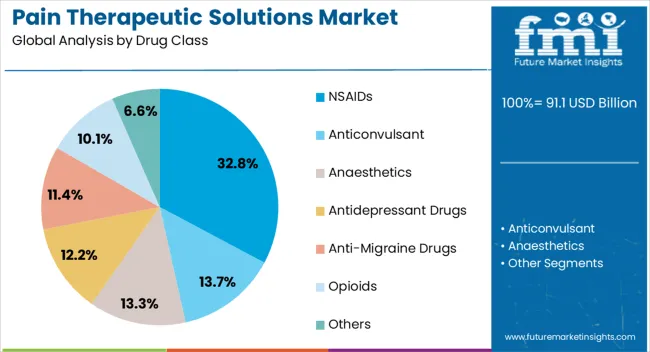
The NSAIDs drug class segment is projected to hold 32.8% of the pain therapeutic solutions market revenue share in 2025, positioning it as the leading drug class. Its dominance is being attributed to the widespread use of non-steroidal anti-inflammatory drugs for the treatment of mild to moderate pain associated with conditions such as arthritis, musculoskeletal injuries, and post-surgical recovery. These drugs are favored for their dual ability to relieve pain and reduce inflammation, making them versatile across multiple therapeutic areas.
The availability of both prescription and over-the-counter formulations has increased accessibility, ensuring broad usage across diverse patient groups. Additionally, the relatively low cost of NSAIDs compared to other classes contributes to their continued preference among healthcare providers and patients.
Continuous advancements in formulations aimed at minimizing gastrointestinal side effects are enhancing patient compliance and safety profiles As the need for cost-effective and widely applicable pain management solutions grows, the NSAIDs segment is expected to maintain its leadership position within the market.
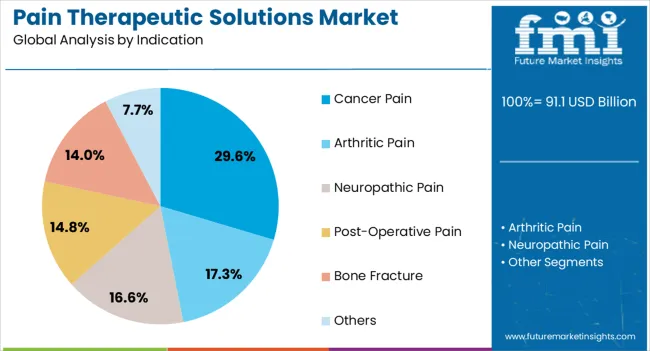
The cancer pain indication segment is anticipated to account for 29.6% of the pain therapeutic solutions market revenue share in 2025, making it the leading indication. Its prominence is being supported by the rising global incidence of cancer and the high prevalence of pain among patients undergoing treatment or experiencing advanced stages of the disease.
Effective pain control has become a central focus in oncology care, with emphasis on improving patient quality of life and enabling adherence to treatment regimens. Pharmaceutical companies are increasingly investing in therapies that address cancer-related pain by targeting specific mechanisms associated with tumor progression and treatment side effects.
Strong demand for both opioid and non-opioid alternatives is being observed in clinical practice, particularly as regulatory bodies promote responsible opioid use and encourage safer therapeutic options With growing oncology patient populations and increasing awareness of the importance of comprehensive pain management, the cancer pain segment is expected to retain its leadership, supported by ongoing innovation and integration of supportive care strategies.
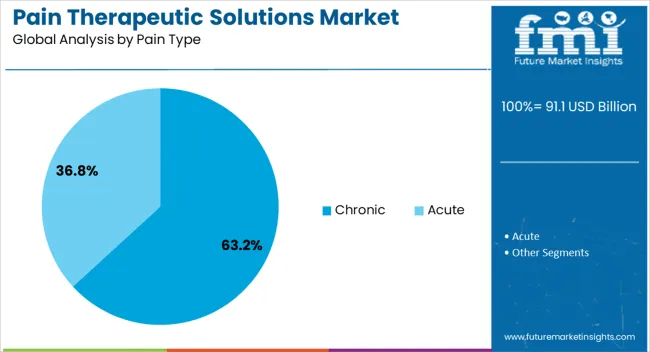
The chronic pain type segment is expected to capture 63.2% of the pain therapeutic solutions market revenue share in 2025, establishing it as the dominant pain type. This leadership is being driven by the high prevalence of chronic conditions such as arthritis, lower back pain, fibromyalgia, and neuropathic disorders that require sustained management over extended periods. Chronic pain significantly affects patient quality of life, leading to strong demand for therapies that provide long-term relief while maintaining safety.
The segment is benefiting from increased awareness among healthcare providers about the importance of early diagnosis and comprehensive treatment approaches. Advances in pharmacological therapies, combined with the use of adjuvant medications and non-pharmacological interventions, are improving outcomes for patients with persistent pain.
Furthermore, the aging global population is contributing to the rising burden of chronic pain, particularly in developed regions As healthcare systems prioritize integrated pain management strategies, the chronic pain segment is projected to continue driving the majority of revenue in the global market.
The need for opioids as a pain reliever is rising in low-income countries as a result of numerous government initiatives to provide palliative care for patients with crippling cancer pain. The increasing use of opioids to treat neuropathic pain is predicted to accelerate the pain management therapeutics market expansion. The overall pain management therapeutics market will grow in the future due to the rise in surgical procedures and the rise in healthcare costs.
The restraints like drug exploitation, the availability of substitutes like pain relief devices, and the patent expiration of prescription painkiller drugs could limit the pain management therapeutics market growth during the forecast period.
The global market for pain management therapeutics can be divided into anaesthetics, anticonvulsants, NSAIDs, anti-migraine medications, opioids, antidepressant medications, non-narcotics, and analgesics based on the drug class. The market for pain management therapeutics can be segmented based on indication into cancer pain, arthritic pain, acute appendicitis, neuropathic pain, chronic pain, post-operative pain, fibromyalgia, migraine, bone fracture, muscle sprain/strain, and others.
The pain management therapeutics market can be divided into chronic pain and acute pain based on the type of pain. The market for pain management therapeutics can be divided into hospital pharmacies, retail pharmacies, and online pharmacies based on the distribution channel.
The pain management therapeutics market in North America is currently the largest and is expected to continue to be so throughout the study period. The high growth in this regional pain management therapeutics market can be attributed to the growing elderly population, the growing adoption of pain management therapeutics for treating neuropathic pain, and the supportive regulatory environment.
The pain management therapeutics market in Asia-Pacific is anticipated to grow at the fastest rate over the forecasted years. The high pain management therapeutics market growth of the region is a result of rising healthcare costs, increased awareness of neuropathic pain management, and a sizable patient base.
In the upcoming years, the Asia Pacific pain management therapeutics market is probably going to expand quickly. It is anticipated that developing nations in the region, like Japan, China, and India, will help to increase awareness of pain management therapeutics products, drive up demand for pain management therapeutics, and make them more readily available.
To increase their market share in pain management therapeutics, key players are focusing on product launches, mergers and acquisitions, partnerships, and collaborations. There are many significant players in the fiercely competitive pain management therapeutics market. There is fierce competition in the pain management therapeutics market because the established players use effective competitive strategies.
One of the key drivers driving the market for pain management therapeutics is the increase in the geriatric population since older people are more likely to experience joint pain and other chronic illnesses.
Furthermore, key drivers expanding the market expansion include rising healthcare costs, favourable regulations and reimbursement for pain management treatments, a greater emphasis on palliative care, and an increase in the number of cancer patients who experience severe pain.
The rising prevalence of chronic diseases including diabetic neuropathy, cancer and osteoarthritis as well as the rise in surgical procedures all contribute to the market growth of pain therapeutic solutions.
Additionally, growing consumer preference for pain therapeutic solutions due to high availability and increased acceptability of pain therapeutic solutions drugs over other treatment options are results of increased consumer awareness of the availability of medications for treating pain.
Geographically, the pain therapeutic solutions market is broadly divided into seven major regions, North America, Latin America, Europe, East Asia, South Asia, Oceania, and the Middle East and Africa.
Among the major regions, North America is expected to hold the largest market share owing to palliative care, favourable reimbursement policies for post-operative care and high awareness of pain management.
On the other hand, the Asian region is expected to emerge as the rapidly growing region in the global pain therapeutic solutions market. The market growth is attributed to the widespread consumer demand for pain relief and reformed regulatory guidelines for the use of pain therapeutic solutions commercially.
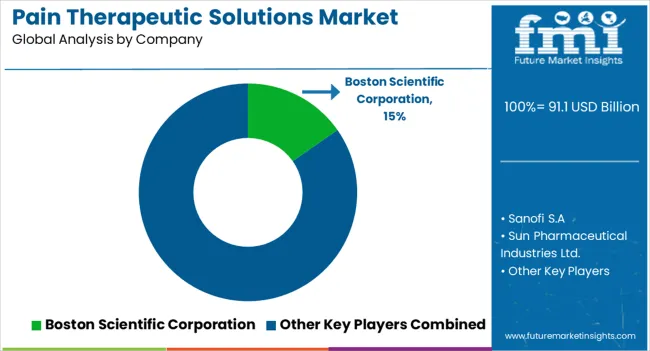
Some of the key manufacturers operating in the pain therapeutic solutions market are Boston Scientific Corporation, Sanofi S.A, Sun Pharmaceutical Industries Ltd., Boehringer Sohn AG & Co. KG, Smiths Medical, St. Jude Medical, Stryker Corporation, Pfizer Inc., Purdue Pharma, Mallinckrodt Pharmaceuticals and Endo Pharmaceuticals Inc.
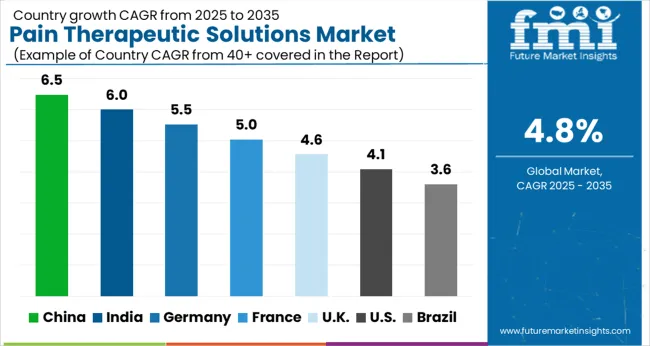
| Country | CAGR |
|---|---|
| China | 6.5% |
| India | 6.0% |
| Germany | 5.5% |
| France | 5.0% |
| UK | 4.6% |
| USA | 4.1% |
| Brazil | 3.6% |
The Pain Therapeutic Solutions Market is expected to register a CAGR of 4.8% during the forecast period, exhibiting varied country level momentum. China leads with the highest CAGR of 6.5%, followed by India at 6.0%. Developed markets such as Germany, France, and the UK continue to expand steadily, while the USA is likely to grow at consistent rates. Brazil posts the lowest CAGR at 3.6%, yet still underscores a broadly positive trajectory for the global Pain Therapeutic Solutions Market. In 2024, Germany held a dominant revenue in the Western Europe market and is expected to grow with a CAGR of 5.5%. The USA Pain Therapeutic Solutions Market is estimated to be valued at USD 32.6 billion in 2025 and is anticipated to reach a valuation of USD 48.6 billion by 2035. Sales are projected to rise at a CAGR of 4.1% over the forecast period between 2025 and 2035. While Japan and South Korea markets are estimated to be valued at USD 4.6 billion and USD 3.2 billion respectively in 2025.
| Item | Value |
|---|---|
| Quantitative Units | USD 91.1 Billion |
| Drug Class | NSAIDs, Anticonvulsant, Anaesthetics, Antidepressant Drugs, Anti-Migraine Drugs, Opioids, and Others |
| Indication | Cancer Pain, Arthritic Pain, Neuropathic Pain, Post-Operative Pain, Bone Fracture, and Others |
| Pain Type | Chronic and Acute |
| Distribution Channel | Hospital Pharmacies, Retail Pharmacies, and Online Pharmacies |
| Regions Covered | North America, Europe, Asia-Pacific, Latin America, Middle East & Africa |
| Country Covered | United States, Canada, Germany, France, United Kingdom, China, Japan, India, Brazil, South Africa |
| Key Companies Profiled | Boston Scientific Corporation, Sanofi S.A, Sun Pharmaceutical Industries Ltd., Boehringer Sohn AG & Co. KG, Smith’s Medical, St. Jude Medical, Stryker Corporation, Pfizer Inc., Purdue Pharma, Mallinckrodt Pharmaceuticals, and Endo Pharmaceuticals Inc. |
The global pain therapeutic solutions market is estimated to be valued at USD 91.1 billion in 2025.
The market size for the pain therapeutic solutions market is projected to reach USD 145.6 billion by 2035.
The pain therapeutic solutions market is expected to grow at a 4.8% CAGR between 2025 and 2035.
The key product types in pain therapeutic solutions market are nsaids, anticonvulsant, anaesthetics, antidepressant drugs, anti-migraine drugs, opioids and others.
In terms of indication, cancer pain segment to command 29.6% share in the pain therapeutic solutions market in 2025.






Our Research Products

The "Full Research Suite" delivers actionable market intel, deep dives on markets or technologies, so clients act faster, cut risk, and unlock growth.

The Leaderboard benchmarks and ranks top vendors, classifying them as Established Leaders, Leading Challengers, or Disruptors & Challengers.

Locates where complements amplify value and substitutes erode it, forecasting net impact by horizon

We deliver granular, decision-grade intel: market sizing, 5-year forecasts, pricing, adoption, usage, revenue, and operational KPIs—plus competitor tracking, regulation, and value chains—across 60 countries broadly.

Spot the shifts before they hit your P&L. We track inflection points, adoption curves, pricing moves, and ecosystem plays to show where demand is heading, why it is changing, and what to do next across high-growth markets and disruptive tech

Real-time reads of user behavior. We track shifting priorities, perceptions of today’s and next-gen services, and provider experience, then pace how fast tech moves from trial to adoption, blending buyer, consumer, and channel inputs with social signals (#WhySwitch, #UX).

Partner with our analyst team to build a custom report designed around your business priorities. From analysing market trends to assessing competitors or crafting bespoke datasets, we tailor insights to your needs.
Supplier Intelligence
Discovery & Profiling
Capacity & Footprint
Performance & Risk
Compliance & Governance
Commercial Readiness
Who Supplies Whom
Scorecards & Shortlists
Playbooks & Docs
Category Intelligence
Definition & Scope
Demand & Use Cases
Cost Drivers
Market Structure
Supply Chain Map
Trade & Policy
Operating Norms
Deliverables
Buyer Intelligence
Account Basics
Spend & Scope
Procurement Model
Vendor Requirements
Terms & Policies
Entry Strategy
Pain Points & Triggers
Outputs
Pricing Analysis
Benchmarks
Trends
Should-Cost
Indexation
Landed Cost
Commercial Terms
Deliverables
Brand Analysis
Positioning & Value Prop
Share & Presence
Customer Evidence
Go-to-Market
Digital & Reputation
Compliance & Trust
KPIs & Gaps
Outputs
Full Research Suite comprises of:
Market outlook & trends analysis
Interviews & case studies
Strategic recommendations
Vendor profiles & capabilities analysis
5-year forecasts
8 regions and 60+ country-level data splits
Market segment data splits
12 months of continuous data updates
DELIVERED AS:
PDF EXCEL ONLINE
Pain Therapeutic Injectables Market Size and Share Forecast Outlook 2025 to 2035
Paint Cans Market Size and Share Forecast Outlook 2025 to 2035
Painting Robots Market Size and Share Forecast Outlook 2025 to 2035
Pain Monitoring Devices Market Size and Share Forecast Outlook 2025 to 2035
Paint Curing Lamp Market Size and Share Forecast Outlook 2025 to 2035
Paint Booth Market Size and Share Forecast Outlook 2025 to 2035
Painkillers Market Size and Share Forecast Outlook 2025 to 2035
Painting Tool Market Size and Share Forecast Outlook 2025 to 2035
Therapeutic Drug Monitoring Market Analysis - Size, Share, and Forecast Outlook 2025 to 2035
Therapeutic Robots Market Size and Share Forecast Outlook 2025 to 2035
Therapeutic Apheresis Market Analysis - Size, Share, and Forecast Outlook 2025 to 2035
Paint Rollers Market Size and Share Forecast Outlook 2025 to 2035
Paint Ingredient Market Size and Share Forecast Outlook 2025 to 2035
Paint Tester Market Size and Share Forecast Outlook 2025 to 2035
Paint Knife Market Size and Share Forecast Outlook 2025 to 2035
Paint Buckets Market Size, Share & Forecast 2025 to 2035
Therapeutic Respiratory Devices Market Overview - Trends & Forecast 2025 to 2035
Paint Mixing Market Analysis - Size, Share, and Forecast Outlook for 2025-2035
Pain Management Devices Market Growth - Trends & Forecast 2025 to 2035
Therapeutic Contact Lenses Market Report - Trends, Demand & Outlook 2025 to 2035

Thank you!
You will receive an email from our Business Development Manager. Please be sure to check your SPAM/JUNK folder too.
Chat With
MaRIA